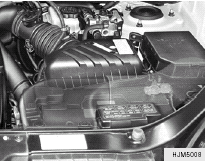 Hyundai Tucson: If the engine will not start
Hyundai Tucson: If the engine will not start
WARNING: If the engine will not start, do not push or pull the car to start it. This could result in a collision or cause other damage. In addition, push or pull starting may cause the catalytic converter to be overloaded and create a fire hazard.
 If Engine Doesn't Turn Over or Turns Over Slowly
If Engine Doesn't Turn Over or Turns Over Slowly
1. If your car has an automatic transaxle, be sure the gear selector lever is in "N" or "P" and the emergency brake is set. 2. Check the battery connections to be sure they are clean and tight. 3. Turn on the interior light. If the light dims or goes out when you operate the starter, the battery is discharged. 4. Check the starter connections to be sure they are securely tightened. 5. Do not push or pull the vehicle to start it. See instructions for "Jump Starting".
If Engine Turns Over Normally but Does Not Start
1. Check fuel level. 2. With the key in the "OFF" position, check all connectors at ignition, coil and spark plugs. Reconnect any that may be disconnected or loose. 3. Check the fuel line in the engine compartment. 4. If the engine still does not start, call a Hyundai dealer or seek other qualified assistance.
If Engine Stalls While Driving
1. Reduce your speed gradually, keeping a straight line. Move cautiously off the road to a safe place. 2. Turn on your emergency flashers. 3. Try to start the engine again. If your vehicle will not start, contact a Hyundai dealer or seek other qualified assistance.
If the engine stalls at a crossroad or crossing
If the engine stalls at a crossroad or crossing, set the shift lever in the N(Neutral) position and then push the vehicle to a safe place.
 Jump starting
Jump starting
WARNING:
The gas produced by the battery during the
jump-start operation is highly explosive. If
these instructions are not followed exactly,
serious personal injury and damage to the
vehi ...
See also:
Installing child restraint LATCH lower anchor
attachments
LATCH webbing-mounted attachment
LATCH compatible child restraints include two
rigid or webbing-mounted attachments that can
be connected to anchors located at certain
seating positions in yo ...
Things you need to know
Operate the system only when
it is
safe to do so.
The requirements of national Road Traffic
Regulations always apply.
Observation of traffic signs and local traffic
regulations always take pri ...
Arming the system
In passive mode, the system will
automatically activate the alarm but
WILL NOT automatically lock the
doors. In order to lock the doors
you must either lock them as indicated
in step 4 b ...

